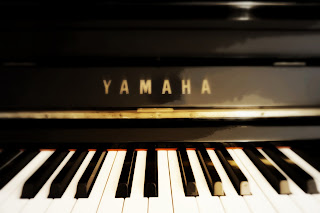Depth: Leading Lines, Reeeeeeeeeepetition, Depth Staging
Depth Staging: In this picture, I used two flowers to demonstrate the contrast. I darkened the background on purpose to create a stronger depth staging effect.
Depth Staging: In this picture, I positioned Ellen to stand in front of the camera and used the pedestrians farther away as the contrast.
Depth Staging: In this picture, I used two objects (3D Crystal Puzzle) to portray the same concept. I also placed the other puzzle on the other corner to display the sense of space between them.
Depth Staging: I angled each Tsum Tsum 45 degrees to build the sense of distance between them. The blackness and whiteness really enhances the concept.
Depth Staging: I added highlights to the picture so that the focus will be on the two roses. I actually had to lower my camera when I was shooting so that the background will be less "messy."
Repetition: The repeating image of me is created by the self-centered mirror at Exploratorium. I added the contrast effect in the picture to intensify the mid-tones.
Repetition: In this picture, I angled my camera in such a way that it captured the whole roll of foundation sticks. As it gets smaller, it also fades away.
Repetition: In this picture, the concept is shown by the way the macaroons are organized. The picture exhibit the simple, yet elegant, nature of structural organization.
Repetition: In this picture, I tried to focus on the first few bottles. Then, I allow the camera to do its work and let the rest of the bottles fade away and get smaller.
Repetition: In this picture, I positioned my lens sideways so that it will capture the repeating carts. The darkened lines of the carts also add a mored dramatic effect.
Leading Lines: In this picture, I captured the tilting slope in such a way that it feels like the slope is leading the viewers to an unseen endpoint.
Leading Lines: In this picture, the blocks revealed both repetition and leading lines. I was trying to make the viewers feel that they can reach a certain point if they keep walking along the path.
Leading Lines: I tried to view the world in different perspective. Therefore, I decided to look up and take a picture of the back of the stairs. This picture shows two leading lines-- one going up, another going down.
Leading Lines: The hallway and the lockers lead the audience to the window. The different tones in the picture also help to establish a peaceful, neutral feeling.
Leading Lines: The buildings, electric lines, and the road all help to create the leading lines. It feels like the endpoint is where the horizon meets the sky.



























































